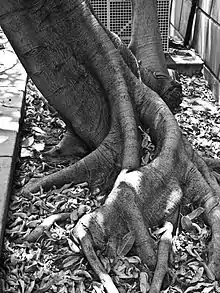Ficus insipida
Ficus insipida is a tropical tree in the fig genus of the family Moraceae. It ranges from Mexico to South America, and is commonly found in cloud forest above 1,550 m ASL.[2][3]
| Ficus insipida | |
|---|---|
 | |
| Roots | |
| Scientific classification | |
| Kingdom: | Plantae |
| Clade: | Tracheophytes |
| Clade: | Angiosperms |
| Clade: | Eudicots |
| Clade: | Rosids |
| Order: | Rosales |
| Family: | Moraceae |
| Genus: | Ficus |
| Subgenus: | F. subg. Pharmacosycea |
| Species: | F. insipida |
| Binomial name | |
| Ficus insipida | |
| Synonyms[1] | |
| |
Description and ecology
This is a tree with buttress roots that ranges from 8–40 m (26–131 ft) tall. Although it is a freestanding tree when mature, F. insipida begins its growth as a climbing vine. It clings to a mature tree, eventually strangling it. Its favored hosts are Guarea tuisana and Sapium pachystachys, and it is also frequently found on already-dead trees.[4][5]
Leaves vary shape from narrow to ellipse-shaped; they range from 5–25 cm (2.0–9.8 in) long and from 2–11 cm (0.79–4.33 in) wide.[6] It flowers February to April and bears warty, yellow-green fruit 4–6 cm in diameter. Though they are edible like most figs, as the scientific name (literally "insipid fig") implies they are of unremarkable taste. Monkeys feed on fruits still on the tree, and fallen fruits are eaten by peccaries.
Two subspecies can be distinguished:
- Ficus insipida ssp. insipida Willd.
- Ficus insipida ssp. scabra C.C.Berg
Use by humans
The wood is soft, but it is used for construction purposes where durability is not important.
F. insipida is used by wajacas (shamans) of the Krahô tribe in Brazil as a memory enhancer.[7] Its latex is also employed in South American folk medicine as the anthelmintic called ojé, but as it is toxic it must be used with care.[8]
Maya codices are folding books stemming from the pre-Columbian Maya civilization, written in Maya hieroglyphic script on Mesoamerican bark cloth, amatl, made from the inner bark of certain trees, the main being the wild fig tree or amate (Ficus glabrata; a synonym of F. insipida).
The inner bark is used by the Moré people of Bolivia to produce a fibrous cloth used for clothing.[9]
References
- "Ficus insipida Willd". Plants of the World Online. Royal Botanic Gardens, Kew. Retrieved 2020-10-09.
- Haber, William (2000): An Introduction to Cloud Forest Trees. Mountain Gem Publications, Monteverde de Puntarenas, Costa Rica. ISBN 9977-12-418-3
- Missouri Botanical Garden [2008a]: Flora de Nicaragua – Ficus insipida [in Spanish]. Retrieved 2008-NOV-01.
- DeWolf, Gordon P. Jr. (1960): Ficus (Tourn.) L.. In: Nevling, Lorin I. Jr.: Flora of Panama. Part IV. Fascicle II. Ann. MO Bot. Gard. 47(2): 81–203. First page image
- Daniels, James D. (1991): Habitat and Host Preferences of Ficus crassiuscula, A Neotropical Strangling Fig of the Lower-Montane Rain Forest. J. Ecol. 79(1): 129–141.
- DeWolf (1960)
- Rodrigues, Eliana & Carlini, E.A. (2006): Plants with possible psychoactive effects used by the Krahô Indians, Brazil. Revista Brasileira de Psiquiatria 28(4): 277–282. PDF fulltext
- Hansson, Anders; Zelada, Julio C. & Noriega, Hugo P. (2005): Reevaluation of risks with the use of Ficus insipida latex as a traditional anthelmintic remedy in the Amazon. Journal of Ethnopharmacology 98(3): 251–257. doi:10.1016/j.jep.2004.12.029 (HTML abstract)
- Leigue Castedo, Luis D. (1957): El Itenez Selvaje. La Paz: Ministerio de Educación
Further reading
- Missouri Botanical Garden [2008b]: Tropicos.org – Ficus insipida synonyms. Retrieved 2008-JUN-29.
External links
- Ficus inspidia Trees, Shrubs, and Palms of Panama, Smithsonian Tropical Research Institute Center for Tropical Forest Science.